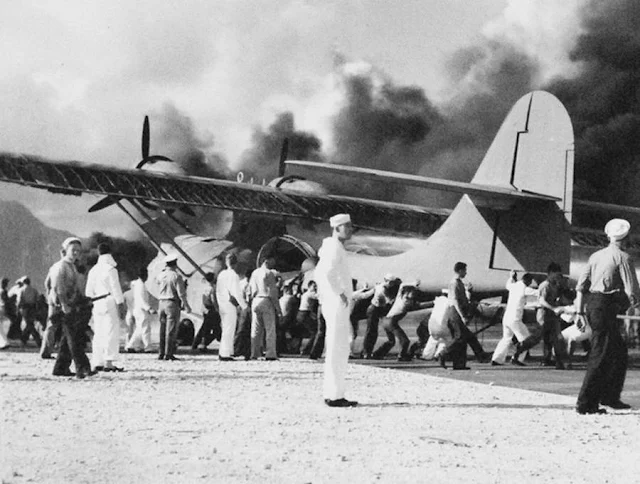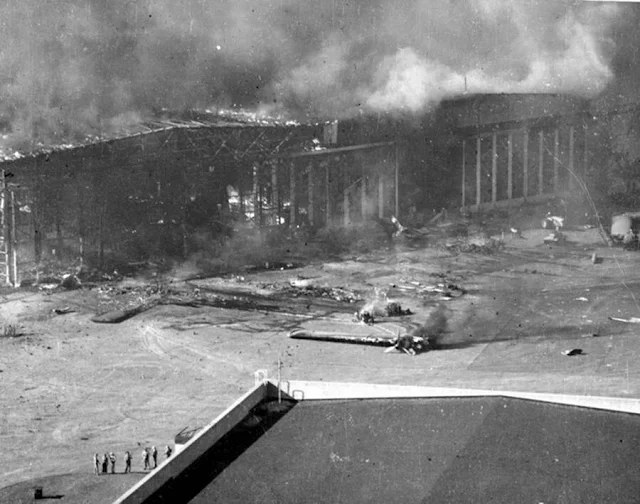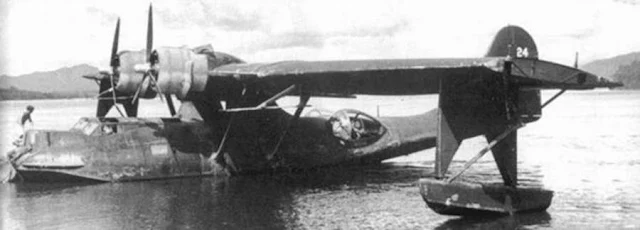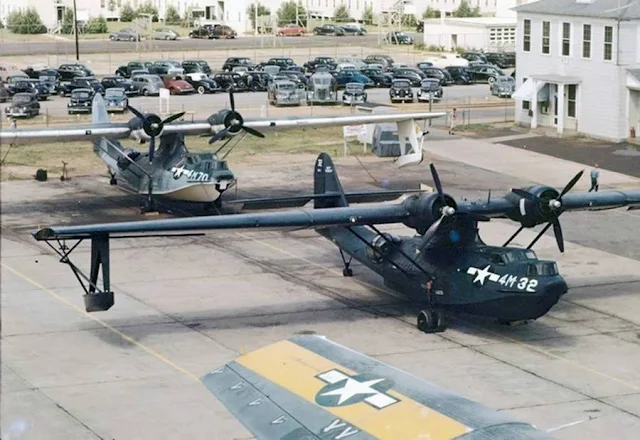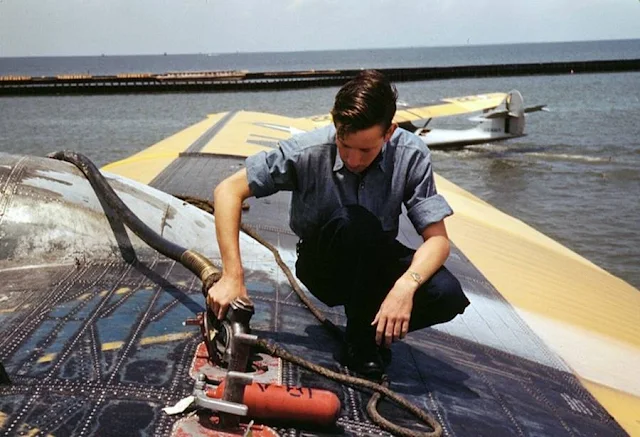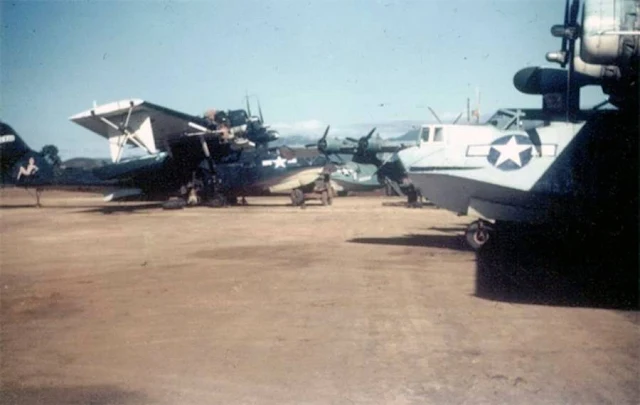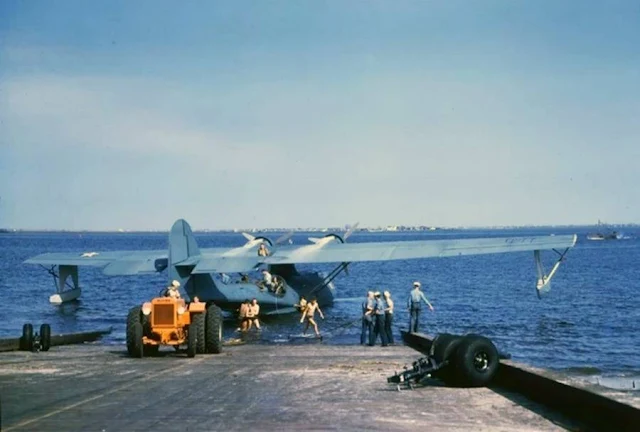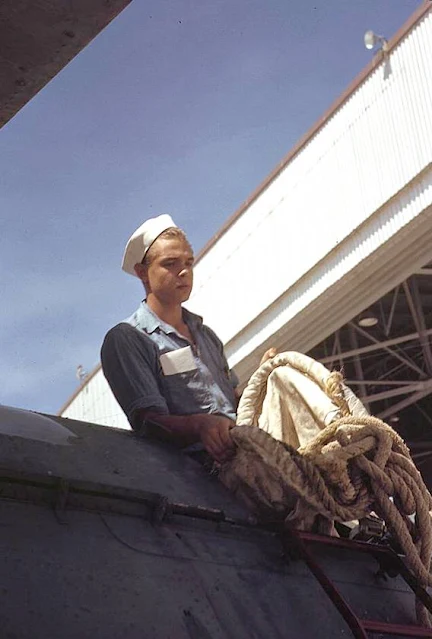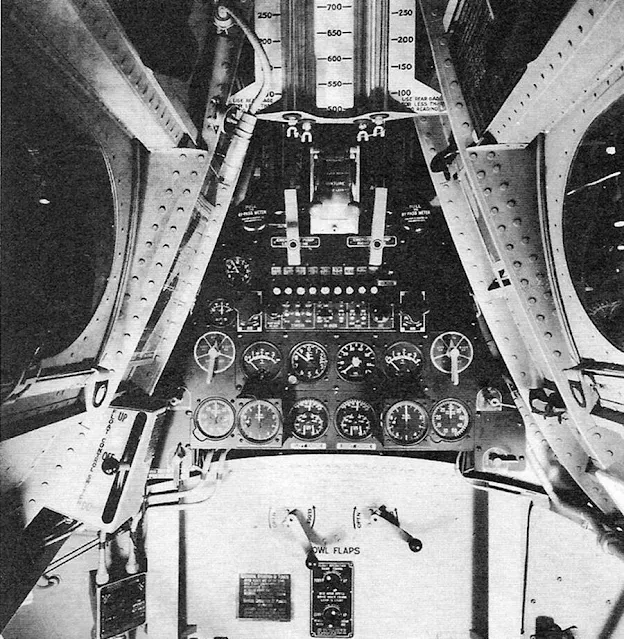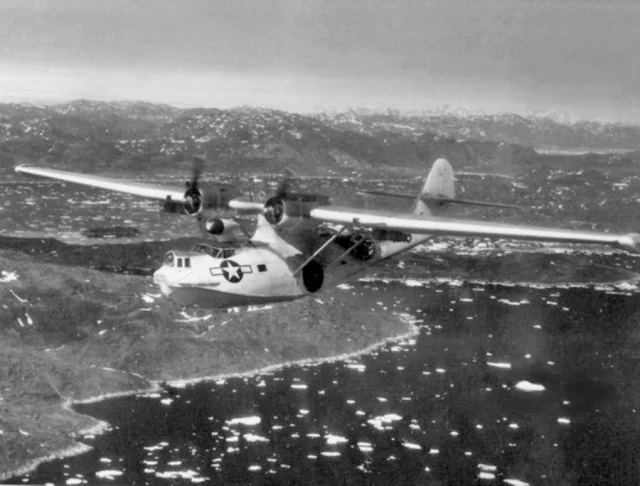 |
| Consolidated PBY-5A Catalina, VP-61, Aleutian Islands. March 1943. Note the radar beneath the wings. |
The Consolidated PBY Catalina, was produced as a flying boat and seaplane amphibian in the 1930s and 1940s. In Canadian service it was known as the Canso. It was one of the most widely used seaplanes of World War II. Catalinas served with every branch of the United States Armed Forces and in the air forces and navies of many other nations. The last military PBYs served until the 1980s. As of 2014, nearly 80 years after its first flight, the aircraft continues to fly as a waterbomber (or airtanker) in aerial firefighting operations in some parts of the world. None remain in military service.
Background
The PBY was originally designed to be a patrol bomber, an aircraft with a long operational range intended to locate and attack enemy transport ships at sea in order to disrupt enemy supply lines. With a mind to a potential conflict in the Pacific Ocean, where troops would require resupply over great distances, the U.S. Navy in the 1930s invested millions of dollars in developing long-range flying boats for this purpose. Flying boats had the advantage of not requiring runways, in effect having the entire ocean available.
Initial Development
As American dominance in the Pacific Ocean began to face competition from Japan in the 1930s, the U.S. Navy contracted Consolidated, Martin and Douglas in October 1933 to build competing prototypes for a patrol flying boat. Naval doctrine of the 1930s and 1940s used flying boats in a wide variety of roles that today are handled by multiple special-purpose aircraft. The U.S. Navy had adopted the Consolidated P2Y and Martin P3M models for this role in 1931, but both aircraft were underpowered and hampered by inadequate range and limited payloads.
Consolidated and Douglas both delivered single prototypes of their new designs, the XP3Y-1 and XP3D-1, respectively. Consolidated's XP3Y-1 was an evolution of the XPY-1 design that had originally competed unsuccessfully for the P3M contract two years earlier and of the XP2Y design that the Navy had authorized for a limited production run. Although the Douglas aircraft was a good design, the Navy opted for Consolidated's because the projected cost was only $90,000 per aircraft.
Consolidated's XP3Y-1 design (company Model 28) had a parasol wing with external bracing struts, mounted on a pylon over the fuselage. Wingtip stabilizing floats were retractable in flight to form streamlined wingtips and had been licensed from the Saunders-Roe company. The two-step hull design was similar to that of the P2Y, but the Model 28 had a cantilever cruciform tail unit instead of a strut-braced twin tail. Cleaner aerodynamics gave the Model 28 better performance than earlier designs. Construction is all-metal, stressed-skin, of aluminum sheet, except the ailerons and wing trailing edge, which are fabric covered.
The prototype was powered by two 825 hp (615 kW) Pratt & Whitney R-1830-54 Twin Wasp radial engines mounted on the wing's leading edges. Armament comprised four .30 in (7.6 mm) Browning AN/M2 machine guns and up to 2,000 lb (910 kg) of bombs.
The XP3Y-1 had its maiden flight on 28 March 1935, after which it was transferred to the U.S. Navy for service trials. The XP3Y-1 was a significant performance improvement over previous patrol flying boats. The Navy requested further development in order to bring the aircraft into the category of patrol bomber, and in October 1935, the prototype was returned to Consolidated for further work, including installation of 900 hp (670 kW) R-1830-64 engines. For the re-designated XPBY-1, Consolidated introduced redesigned vertical tail surfaces which resolved a problem with the tail becoming submerged on takeoff, which had made lift-off impossible under some conditions. The XPBY-1 had its maiden flight on 19 May 1936, during which a record non-stop distance flight of 3,443 mi (2,992 nmi; 5,541 km) was achieved.
The XPBY-1 was delivered to VP-11F in October 1936. The second squadron to be equipped was VP-12, which received the first of its aircraft in early 1937. The second production order was placed on 25 July 1936. Over the next three years, the design was gradually developed further and successive models introduced.
The aircraft eventually bore the name Catalina after Santa Catalina Island, California; the name was coined in November 1941, as Great Britain ordered their first 30 aircraft.
PBN Nomad
The Naval Aircraft Factory made significant modifications to the PBY design, many of which would have significantly interrupted deliveries had they been incorporated on the Consolidated production lines. The new aircraft, officially known as the PBN-1 Nomad, had several differences from the basic PBY. The most obvious upgrades were to the bow, which was sharpened and extended by two feet, and to the tail, which was enlarged and featured a new shape. Other improvements included larger fuel tanks, increasing range by 50%, and stronger wings permitting a 2,000 lb (908 kg) increase in gross takeoff weight. An auxiliary power unit was installed, along with an improved electrical system, and the weapons were upgraded with continuous-feed mechanisms.
138 of the 156 PBN-1s produced served with the Soviet Navy. The remaining 18 were assigned to training units at NAS Whidbey Island and the Naval Air Facility in Newport, Rhode Island. Later, improvements found in the PBN such as the larger tail were incorporated into the amphibious PBY-6A.
Naming
The designation "PBY" was determined in accordance with the U.S. Navy aircraft designation system of 1922; PB representing "Patrol Bomber" and Y being the code assigned to Consolidated Aircraft as its manufacturer. Catalinas built by other manufacturers for the U.S. Navy were designated according to different manufacturer codes, thus Canadian Vickers-built examples were designated PBV, Boeing Canada examples PB2B (there already being a Boeing PBB) and Naval Aircraft Factory examples were designated PBN. In accordance with contemporary British naming practice of naming seaplanes after coastal port towns, Royal Canadian Air Force examples were named Canso, for the town of that name in Nova Scotia. The Royal Air Force used the name Catalina and the U.S. Navy adopted this name in 1942. The United States Army Air Forces and later the United States Air Force used the designation OA-10. U.S. Navy Catalinas used in the Pacific against the Japanese for night operations were painted black overall; as a result these aircraft were sometimes referred to locally as "Black Cats".
Roles in World War II
The PBY was the most numerous aircraft of its kind, with around 3,300 aircraft were built. During World War II, PBYs were used in anti-submarine warfare, patrol bombing, convoy escort, search and rescue missions (especially air-sea rescue), and cargo transport. The type operated in nearly all operational theatres of World War II. The Catalina served with distinction and played a prominent and invaluable role in the war against the Japanese.
These patrol planes shared with land based patrol bombers the combat roles while the very long range Consolidated LB-30 and the Consolidated Coronado were pressed into service to increase the all-important logistic strategic air lift capability in the vast Pacific theater. The pairings allowed the Catalina to take on the role of eyes of the fleets at longer ranges than the float plane scouts.
Several different flying boats were adopted by the Navy, but the PBY was the most widely used and produced.
Although slow and ungainly, Catalinas distinguished themselves in World War II. Allied forces used them successfully in a wide variety of roles for which the aircraft was never intended. PBYs are remembered for their rescue role, in which they saved the lives of thousands of aircrew downed over water. Catalina airmen called their aircraft the "Cat" on combat missions and "Dumbo" in air-sea rescue service.
Anti-submarine Warfare
Catalinas were the most extensively used anti-submarine warfare (ASW) aircraft in both the Atlantic and Pacific theaters of World War II, and were also used in the Indian Ocean, flying from the Seychelles and from Ceylon. Their duties included escorting convoys to Murmansk. By 1943, U-boats were well-armed with anti-aircraft guns and two Victoria Crosses were won by Catalina pilots pressing home their attacks on U-boats in the face of heavy fire: Flying Officer John Cruickshank of the RAF, in 1944, for sinking U-347 (although the submarine is now known to have been U-361) and in the same year Flight Lieutenant David Hornell of the Royal Canadian Air Force (posthumously) against U-1225. Catalinas destroyed 40 U-boats, but not without losses of their own. A Brazilian Catalina attacked and sank U-199 in Brazilian waters on 31 July 1943. Later, the aircraft was baptized as "Arará", in memory of the merchant ship of that name which was sunk by another U-boat.
Maritime Patrol
In their role as patrol aircraft, Catalinas participated in some of the most notable naval engagements of World War II. The aircraft's parasol wing and large waist blisters provided excellent visibility and combined with its long range and endurance, made it well suited for the task.
A RAF Coastal Command Catalina, piloted by Ensign Leonard B. Smith of the U.S. Navy and flying out of Castle Archdale Flying boat base, Lower Lough Erne, Northern Ireland, located on 26 May 1941, some 690 nmi (1,280 km; 790 mi) northwest of Brest, the German battleship Bismarck, which was attempting to evade Royal Navy forces as she sought to join other Kriegsmarine forces in Brest. This sighting eventually led to the destruction of the German battleship.
On 7 December 1941, before the Japanese amphibious landings on Kota Bharu, Malaya, their invasion force was approached by a Catalina flying boat of No. 205 Squadron RAF. The aircraft was shot down by five Nakajima Ki-27 fighters before it could radio its report to air headquarters in Singapore. Flying Officer Patrick Bedell, commanding the Catalina, and his seven crew members became the first Allied casualties in the war with Japan.
A flight of Catalinas spotted the Japanese fleet approaching Midway Island, beginning the Battle of Midway.
A Royal Canadian Air Force (RCAF) Canso flown by Squadron Leader L.J. Birchall foiled Japanese plans to destroy the Royal Navy's Indian Ocean fleet on 4 April 1942 when it detected the Japanese carrier fleet approaching Ceylon (Sri Lanka).
Night Attack and Naval Interdiction
During the Battle of Midway four USN PBYs of Patrol Squadrons 24 and 51 made an attack on the occupation force of the Japanese fleet on the night of June 3–4, 1942.
The Royal Australian Air Force (RAAF) also operated Catalinas as night raiders, with four squadrons Nos. 11, 20, 42, and 43 laying mines from 23 April 1943 until July 1945 in the southwest Pacific deep in Japanese-held waters, bottling up ports and shipping routes and forcing ships into deeper waters to become targets for U.S. submarines; they tied up the major strategic ports such as Balikpapan which shipped 80% of Japanese oil supplies. In late 1944, their mining missions sometimes exceeded 20 hours in duration and were carried out from as low as 200 ft (61 m) in the dark. Operations included trapping the Japanese fleet in Manila Bay in assistance of General Douglas MacArthur's landing at Mindoro in the Philippines. Australian Catalinas also operated out of Jinamoc in the Leyte Gulf, and mined ports on the Chinese coast from Hong Kong to as far north as Wenchow. Both USN and RAAF Catalinas regularly mounted nuisance night bombing raids on Japanese bases, with the RAAF claiming the slogan "The First and the Furthest". Targets of these raids included a major base at Rabaul. RAAF aircrews, like their U.S. Navy counterparts, employed "terror bombs", ranging from scrap metal and rocks to empty beer bottles with razor blades inserted into the necks, to produce high pitched screams as they fell, keeping Japanese soldiers awake and scrambling for cover.
Search and Rescue
Catalinas were employed by every branch of the U.S. military as rescue aircraft. A PBY piloted by LCDR Adrian Marks (USN) rescued 56 sailors in high seas from the heavy cruiser Indianapolis after the ship was sunk during World War II. When there was no more room inside, the crew tied sailors to the wings. The aircraft could not fly in this state; instead it acted as a lifeboat, protecting the sailors from exposure and the risk of shark attack, until rescue ships arrived. Catalinas continued to function in the search-and-rescue role for decades after the end of the war.
Early Commercial Use
Catalinas were also used for commercial air travel. For example, Qantas Empire Airways flew commercial passengers from Suva to Sydney, a journey of 2,060 miles (3,320 km), which in 1949 took two days. The longest commercial flights (in terms of time aloft) ever made in aviation history were the Qantas flights flown weekly from 29 June 1943 through July 1945 over the Indian Ocean, dubbed the Double Sunrise. Qantas offered non-stop service between Perth and Colombo, a distance of 3,592 nmi (4,134 mi; 6,652 km). As the Catalina typically cruised at 110 kn (130 mph; 200 km/h), this took from 28 to 32 hours and was called the "flight of the double sunrise", since the passengers saw two sunrises during their non-stop journey. The flight was made in radio silence because of the possibility of Japanese attack and had a maximum payload.
Post-World War II Employment
An Australian PBY named "Frigate Bird II", an ex RAAF aircraft, registered VH-ASA, made the first trans-Pacific flight across the South Pacific between Australia and Chile in 1951 by (Sir) Gordon Taylor, making numerous stops at islands along the way for refueling, meals, and overnight sleep of its crew, flown from Sydney to Quintero in Chile after making initial landfall at Valparaiso via Tahiti and Easter Island.
With the end of the war, all of the flying boat versions of the Catalina were quickly retired from the U.S. Navy, but the amphibious versions remained in service for some years. The last Catalina in U.S. service was a PBY-6A operating with a Naval Reserve squadron, which was retired from use on 3 January 1957. The Catalina subsequently equipped the world's smaller armed services into the late 1960s in fairly substantial numbers.
The U.S. Air Force's Strategic Air Command used Catalinas (designated OA-10s) in service as scout aircraft from 1946 through 1947.
The Brazilian Air Force flew Catalinas in naval air patrol missions against German submarines starting in 1943. The flying boats also carried out air mail deliveries. In 1948, a transport squadron was formed and equipped with PBY-5As converted to the role of amphibious transports. The 1st Air Transport Squadron (ETA-1) was based in the port city of Belem and flew Catalinas and C-47s until 1982. Catalinas were convenient for supplying military detachments scattered along the Amazon. They reached places that were otherwise accessible only by helicopters. The ETA-1 insignia was a winged turtle with the motto "Though slowly, I always get there". Today, the last Brazilian Catalina (a former RCAF one) is displayed at the Airspace Museum (MUSAL) in Rio de Janeiro.
Jacques-Yves Cousteau used a PBY-6A (N101CS) to support his diving expeditions. His second son, Philippe, was killed in an accident in this aircraft that occurred on the Tagus River near Lisbon. The Catalina nosed over during a high-speed taxi run undertaken to check the hull for leakage following a water landing. The aircraft turned upside down, causing the fuselage to break behind the cockpit. The wing separated from the fuselage and the left engine broke off, penetrating the captain's side of the cockpit.
Paul Mantz converted an unknown number of surplus Catalinas to flying yachts at his Orange County California hangar in the late 1940s and early 1950s.
Steward-Davis converted several Catalinas to their Super Catalina standard (later known as Super Cat), which replaced the usual 1,200 hp (890 kW) Pratt & Whitney R-1830 Twin Wasp engines with Wright R-2600 Cyclone 14 engines of 1,700 hp (1,300 kW). A larger, squared-off rudder was installed to compensate for the increased yaw which the more powerful engines could generate. The Super Catalina also had extra cabin windows and other alterations.
Chilean Air Force (FACH) Captain Roberto Parragué, in his PBY Catalina FACH No. 405 called "Manu-Tara", which means Lucky Bird in the Rapanui language, undertook the first flight between Easter Island and the continent of South America (from Chile), as well as the first flight to Tahiti, making him a national hero of France as well as of Chile. The flight was authorized by the Chilean President in 1951, but a second flight he made in 1957 was not authorized, and he was dismissed from the Chilean Air Force.
Of the few dozen remaining airworthy Catalinas, the majority are in use as aerial firefighting aircraft. China Airlines, the official airline of the Republic of China (Taiwan) was founded with two Catalina amphibians.
Platforms are folded out and deployed from Catalinas for use in open ocean fishing and Mahi Mahi tracking in the Pacific Ocean.
Possible Revival
In July 2023 a company called Catalina Aircraft, current holder of the Type Certificates for the Catalina, announced an intent to build the Catalina II, a new aircraft on the basic design principles of the original Catalina but using turboprop engines and other modern aviation tools. Deliveries are said to commence by 2029.
Catalina Affair
The Catalina Affair is the name given to a Cold War incident in which a Swedish Air Force Catalina was shot down by Soviet fighters over the Baltic Sea in June 1952 while investigating the disappearance of a Swedish Douglas DC-3 (later found to have been shot down by a Soviet fighter while on a signals intelligence mission; it was found in 2003 and raised 2004–2005).
*
Role: Maritime patrol bomber, search and rescue seaplane
National origin: United States
Manufacturer: Consolidated Aircraft
Built by:
Boeing Canada (PB2B)
Canadian Vickers (PBV)
Naval Aircraft Factory (PBN)
First flight: 28 March 1935
Introduction: October 1936, United States Navy
Retired:
January 1957 (United States Navy Reserve)
1979 (Brazilian Air Force)
Primary users:
United States Navy
United States Army Air Forces
Royal Air Force
Royal Canadian Air Force
Produced: 1936–1945
Number built:
3,305
2,661 U.S.-built
620 Canadian-built
Soviet-built
Unit cost: US$90,000 (as of 1935, $1.68 million today)
Variants
An estimated 4,051 Catalinas, Cansos, and GSTs of all versions were produced between June 1937 and May 1945 for the U.S. Navy, the United States Army Air Forces, the United States Coast Guard, Allied nations, and civilian customers.
US Navy
XP3Y-1: Prototype Model 28 flying boat later re-designated XPBY-1, one built (USN Bureau No. 9459). Later fitted with a 48-foot-diameter (15 m) ring to sweep magnetic sea mines. A 550 hp Ranger engine drove a generator to produce a magnetic field.
XPBY-1: Prototype version of the Model 28 for the United States Navy, a re-engined XP3Y-1 with two 900 hp R-1830-64 engines, one built.
PBY-1 (Model 28-1): Initial production variant with two 900 hp R-1830-64 engines, 60 built.
PBY-2 (Model 28-2): Equipment changes and improved performance, 50 built.
PBY-3 (Model 28-3): Powered by two 1,000 hp R-1830-66 engines, 66 built.
PBY-4 (Model 28-4): Powered by two 1,050 hp R-1830-72 engines, 33 built (including one initial as a XPBY-4 which later became the XPBY-5A).
PBY-5 (Model 28-5): Either two 1,200 hp R-1830-82 or −92 engines and provision for extra fuel tanks (with partial self-sealing protection). 683 built (plus one built at New Orleans), some aircraft to the RAF as the Catalina IVA and one to the United States Coast Guard. The PBY-5 was also built in the Soviet Union as the GST.
XPBY-5A: One PBY-4 converted into an amphibian and first flown in November 1939.
PBY-5A (Model 28-5A): Amphibious version of the PBY-5 with two 1,200 hp R-1830-92 engines, first batch (of 124) had one 0.3in bow gun, the remainder had two bow guns; 803 built including diversions to the United States Army Air Forces, the RAF (as the Catalina IIIA) and one to the United States Coast Guard.
Crew: 10 (pilot, co-pilot, bow turret gunner, flight engineer, radio operator, navigator, radar operator, two waist gunners and ventral gunner)
Length: 63 ft 10.875 in (19.47863 m)
Wingspan: 104 ft (32 m)
Height: 21 ft 1 in (6.43 m)
Wing area: 1,400 sq ft (130 m2)
Aspect ratio: 7.73
Empty weight: 20,910 lb (9,485 kg)
Maximum takeoff weight: 35,420 lb (16,066 kg)
Zero-lift drag coefficient: 0.0309
Drag area: 43.26 ft2 (4.02 m2)
Power plant: 2 × Pratt & Whitney R-1830-92 Twin Wasp 14-cylinder air-cooled radial piston engines, 1,200 hp (890 kW) each
Propellers: 3-bladed constant-speed propellers
Maximum speed: 196 mph (315 km/h, 170 kn)
Cruise speed: 125 mph (201 km/h, 109 kn)
Range: 2,520 mi (4,060 km, 2,190 nmi)
Service ceiling: 15,800 ft (4,800 m)
Rate of climb: 1,000 ft/min (5.1 m/s)
Lift-to-drag: 11.9
Wing loading: 25.3 lb/sq ft (124 kg/m2)
Armament:
3 x .30 cal (7.62 mm) machine guns (two in nose turret, one in ventral hatch at tail)
2 x .50 cal (12.7 mm) machine guns (one in each waist blister)
4,000 lb (1,814 kg) of bombs or depth charges
torpedo racks were also available
PBY-5R: The XPBY-5A converted into a staff transport, with amphibious gear and nose turret removed and additional windows added.
PBY-6A: Amphibious version with two 1,200 hp R-1830-92 engines and a taller fin and rudder. Radar scanner fitted above cockpit and two 0.5 in nose guns; 175 built including 21 transferred to the Soviet Navy.
PBY-6AG: One PBY-6A used by the United States Coast Guard as a staff transport.
PB2B-1: Boeing Canada built PBY-5 for the RAF and RCAF from 1942. 240 built.
PB2B-2: Boeing Canada built version of the PBY-5 but with the taller fin of the PBN-1. 67 built. Most supplied to the RAF as the Catalina VI.
PBN-1 Nomad: Naval Aircraft Factory built version of the PBY-5 with major modification including a 2ft bow extension, modified hull lines with a modified step, re-designed wingtip floats and tail surfaces and a revised electrical system. A total of 155 were built for delivery to the RAF as the Catalina V although 138 were Lend-Leased to the Soviet Navy as the KM-1
PBV-1A: Canadian Vickers built version of the PBY-5A, 380 built including 150 to the Royal Canadian Air Force as the Canso-A and the rest to the USAAF as the OA-10A.
USAAF
OA-10: United States Army Air Forces designation for PBY-5A, 105 built; 58 aircraft survivors re-designated A-10 in 1948.
OA-10A: USAAF designation of Canadian Vickers-built version of the PBV-1A, 230 built. Survivors re-designated A-10A in 1948. Three additional aircraft from Navy in 1949 as A-10As.
OA-10B: USAAF designation of PBY-6A, 75 built. Re-designated A-10B in 1948.
RAF
Catalina I: Direct purchase aircraft for the Royal Air Force, same as the PBY-5 with six 0.303 in guns (one in bow, four in waist blisters and one aft of the hull step) and powered by two 1,200 hp R-1830-S1C3-G engines, 109 built.
Catalina IA: Operated by the Royal Canadian Air Force as the Canso, 14 built.
Catalina IB: Lend-lease PBY-5Bs for the RAF, 225 aircraft built.
Catalina II: Equipment changes, six built.
Catalina IIA: Vickers-Canada built Catalina II for the RAF, 50 built.
Catalina IIIA: Former U.S. Navy PBY-5As used by the RAF on the North Atlantic Ferry Service, 12 aircraft. These were the only amphibians that saw RAF service.
Catalina IVA: Lend-lease PBY-5s for the RAF, 93 aircraft.
Catalina IVB: Lend-lease PB2B-1s for the RAF, some to the Royal Australian Air Force.
Catalina VI: Lend-lease PB2B-2s for the RAF, some to the RAAF.
RCAF
Canso-A: RCAF designation for PBV-1A
Other Users
GST: Soviet-built version of the PBY-5 ("Gydro Samoliot Transportnyi").
Steward-Davis Super Catalina ("Super Cat"): Catalina converted to use 1,700 hp Wright R-2600 Cyclone 14 engines, with enlarged rudder and other changes.
Avalon Turbo Canso: A proposed turboprop conversion of Canso water bombers, powered by two Rolls-Royce Dart engines.
NGAA Catalina II: A proposed modernized version of the Catalina ("Next Generation Amphibious Aircraft"), developed by Catalina Aircraft Systems which holds ownership of the PBY-5's type certificate as of 2023. The design has been proposed in civil and military versions.
Production
Deliveries of Production Consolidated Variants to US Navy Only
|
Model |
Production period |
Quantity |
|
PBY-1 |
Sep 1936 – Jun 1937 |
60 |
|
PBY-2 |
May 1937 – Feb 1938 |
50 |
|
PBY-3 |
Nov 1936 – Aug 1938 |
66 |
|
PBY-4 |
May 1938 – Jun 1939 |
32 |
|
PBY-5 |
Sep 1940 – Jul 1943 |
684 |
|
PBY-5A |
Oct 1941 – Jan 1945 |
802 |
|
PBY-6A |
Jan 1945 – May 1945 |
175 |
Argentina: Argentine Naval Aviation 17 "Canso" received 1946-48
Australia: The Royal Australian Air Force operated the PBY Catalina extensively. The Royal Australian Air Force ordered its first 18 PBY-5s (named Catalina) in 1940, around the same time as French purchase. Some of these would be used to re-establish the British-Australian air link through Asia as the Double Sunrise. By the end of the war the RAAF had taken delivery of 168 Catalinas. The RAAF used Catalinas in a wide range of roles including reconnaissance and anti-submarine patrols, offensive mine-laying and air-sea rescue, the deployment of folboats (collapsible canoes), notably the Hoehn Mk III military type for Commando raids. The rescue of personnel and closer visual observation, as well as psychological warfare. In addition, RAAF PBYs were used to transport Australian personnel home at the end of the war. The RAAF retired its last Catalina in 1952.
Royal Australian Air Force
No. 11 Squadron RAAF
No. 20 Squadron RAAF observation
No. 40 Squadron RAAF had aircraft placed on establishment, but not actually issued.
No. 42 Squadron RAAF
No. 43 Squadron RAAF
No. 6 Communication Unit RAAF
No. 8 Communication Unit RAAF
No. 111 Air-Sea Rescue Flight RAAF
No. 112 Air-Sea Rescue Flight RAAF
No. 113 Air-Sea Rescue Flight RAAF
Seaplane Training Flight RAAF
No. 3 Operational Training Unit RAAF
Search and Rescue Wing RAAF
Brazil: 1st Air Transport Squadron (ETA-1)
Canada: Canada had its own close associations with the PBY, both as a manufacturer and customer. Under an agreement reached between the Canadian and U.S. governments, production lines were laid down in Canada, by Boeing Aircraft of Canada (as the PB2B-1) in Vancouver, and by Canadian Vickers (PBV-1) at the Canadair plant in Cartierville. Canadian manufactured aircraft serving with the RCAF were known as Canso A, and were equivalent to PBY-5A (with retractable landing gear). Eleven Canadian Home War Establishment squadrons flew Cansos and Lend Lease Catalinas and on both sides of the North Atlantic and on the Pacific West Coast of Canada. Two "overseas" squadrons flew from the British Isles, as well as over the Indian Ocean.
Royal Canadian Air Force
Article XV squadrons serving under direct command and control of the RAF, with RAF owned aircraft.
No. 413 Squadron RCAF Catalina I/IB/IV (Jul 41 - Dec 44) (UK and Ceylon).
No. 422 Squadron RCAF Catalina IB/III/IV (Jul 42 - Nov 42) (while working up to operational status).
Operational Squadrons of the Home War Establishment (HWE) (Based in Canada)
Eastern Air Command
No. 5 Squadron RCAF Catalina I (Jun 41 - Jul 41); Canso A (Oct 41 - Jun 45)
No. 116 Squadron RCAF Catalina I/IB (Jul 41 - Aug 43); Canso A (Sep 43 - Jun 45)
No. 117 Squadron RCAF Catalina I/IB/IVA (May 42 - Dec 43); Canso A (May 42 - Aug 43)
No. 160 Squadron RCAF Canso A (May 43 - Jun 45)
No. 161 Squadron RCAF Canso A (Nov 43 - May 45)
No. 162 Squadron RCAF Canso A (May 42 - Aug 45)
Western Air Command
No. 4 Squadron RCAF Canso A (Dec 42 - Aug 45); Catalina IB/IVA (Apr 44 - Aug 44)
No. 6 Squadron RCAF Canso A (Apr 43 - Nov 43); Catalina IB/IVA (Sept 43 - Aug 45)
No. 7 Squadron RCAF Catalina IVA (Jan 44 - Jul 45); Canso A (Apr 44 - Jul 45)
No. 9 Squadron RCAF Canso A (Apr 43 - Aug 44); Catalina I/IB/IVA (Feb 44 - Aug 44)
No. 120 Squadron RCAF Canso A (Apr 43 - Sep 43); Catalina IVA (Sep 43 - Apr 44)
103 Search and Rescue Squadron
Chile
China: The Republic of China Air Force operated PBY-5A as search and rescue (SAR) plane from 1952 to 1954. At least one of these PBY-5A were later transferred to China Airlines in the 1959.
Colombia
Colombian Air Force
SATENA
Avianca
AIDA
Aeropesca
VIARCO
Cuba: Cuban Navy 1952-1961
Denmark: Royal Danish Air Force
No. 721 Squadron RDAF received aircraft from No. 722 Squadron RDAF in 1965.
No. 722 Squadron RDAF transferred aircraft to No. 721 Squadron RDAF in 1965.
Dominican Republic
Ecuador
France: Soon after the receipt of Britain's first order for production aircraft, a French purchasing mission ordered 30 aircraft in early 1940. Allocated the Consolidated identification Model 28-5MF, none of these were delivered before the Battle of France.
Iceland
Icelandic Coast Guard
ICG Aeronautical Division
Israel: Israeli Air Force
69 Squadron
Japan: Japan Maritime Self-Defense Force
No. 91 Squadron JMSDF
Mexico
Netherlands: Netherlands ordered 48 planes for use in the Dutch East Indies.
Royal Netherlands Air Force
No. 321 Squadron RAF (1942-1945) squadron transferred to the Royal Netherlands Air Force
Dutch Naval Aviation Service
New Zealand: From 1942 New Zealand used 56 non-amphibious PBY-5 and PB2B-1 Catalinas in the South Pacific, to replace the Short Singapore with the Royal New Zealand Air Force's 5 Squadron and 6 Squadron, initially operating out of Hobsonville and Fiji on maritime patrol and air-sea rescue roles. Additional RAF-owned aircraft were used by 490 (NZ) Squadron in the anti-submarine role during the battle of the Atlantic. 490 squadron operated Catalinas out of Jui, West Africa, from 1943 until they were superseded by Short Sunderlands in 1944. The last RNZAF Catalinas were retired in 1953 and all had been sold or scrapped by the end of 1956. An airworthy PBY-5A Catalina amphibian in 6 Squadron markings is privately owned. The Royal New Zealand Air Force Museum is restoring a former fire training Catalina.
Royal New Zealand Air Force
No. 5 Squadron RNZAF
No. 6 Squadron RNZAF
No. 490 Squadron RNZAF (1943-1945)
Nicaragua: Nicaraguan Air Force
Norway: Royal Norwegian Air Force
No. 330 (Norwegian) Squadron RAF (1942-1943)
No. 333 (Norwegian) Squadron RAF (1943-1945) transferred to the Royal Norwegian Air Force in November 1945
Paraguay: Paraguayan Air Force originally ordered three PBY-5As in 1955. One was destroyed in the U.S. before delivery. The other two reached Paraguay and received serials T-29 and T-31. T-29 rescued ex-President Perón in October 1955 in Argentina. Both aircraft were transferred to Líneas Aéreas de Transporte Nacional (LATN) in 1956.
Peru
Philippines
South Africa: Consolidated Catalina PBY's were flown by 6, 10 and 43 Squadrons of the South African Air Force during World War II. The squadrons and aircraft were placed under command of SAAF Coastal Command and operated on the South African Indian and Atlantic coastlines. After World War II, Catalinas were utilized by 35 Squadron from 1945 to 1957.
Spain: The Spanish Air Force used one unit, under DR.1 designation and 74-21 indication, as a patrol bomber and firefighter plane between 1949 and 1954. This aircraft was a United States Army Air Forces unit, which landed by accident in the Spanish Sahara in 1943, and finally it was sold to the Spanish Air force for approximately US$100,000. It is currently on display at the Museo del Aire (Madrid).
Spanish Air Force
Sweden: Three Canso amphibians, built by Canadian-Vickers, were bought by the Swedish Air Force in 1947. The Swedish designation was Tp 47. After modifications for their new post-war missions, they were based at Wing F2 at Hägernäs near Stockholm and were used mainly for air and sea rescue service. Also reconnaissance missions were flown. The Tp 47 was equipped with PS-19/A radar. The aircraft had a crew of five and had also room for six stretchers. It was powered by two Pratt & Whitney R-1830-92 Twin Wasp 14-cylinder radial engines of 1.200 hp each. It was unarmed.
Swedish Air Force
Soviet Union: The Soviet Union had shown an interest, resulting in an order for three aircraft and the negotiation of a license to build the type in USSR. When these three machines were delivered they were accompanied by a team of Consolidated engineers who assisted in establishment of the Soviet production facilities. This aircraft model, designated GST, was powered by two Wright R-1820-derived, nine-cylinder Shvetsov M-62 or ASh-62IR single-row radial engines of 900 to 1,000 hp (671 to 746 kW). The first GST entered service towards the end of 1939. It is estimated hundreds more served with the Soviet Navy. Soviet Union also received 138 PBN-1 Nomad variant of the Catalina built by the Naval Aircraft Factory in Philadelphia along with 48 PBY-6As under the Lend-Lease Act.
Soviet Naval Aviation
United Kingdom: The British Air Ministry purchased a single aircraft for evaluation purposes, the Model 28-5. This was flown across the Atlantic Ocean to the Marine Aircraft Experimental Establishment, Felixstowe, in July 1939. With the outbreak of war anticipated, the trials were terminated prematurely, and an initial 50 aircraft were ordered under "Catalina I". These aircraft were similar to the PBY-5, except for installation of British armament. The name Catalina had been used by Consolidated for their commercial sales prior to the British order, and was eventually adopted by the US Navy on October 1, 1941.
Initial deliveries of the Royal Air Force's Catalinas began in early 1941 and these entered service with No. 209 and No. 240 squadrons of Coastal Command. In all, nine squadrons of Coastal Command were equipped with the Catalina, as were an additional 12 squadrons overseas. The total acquisition was approximately 700 spread over the following designations: Catalina Mk I, Mk IA (PBY-5A amphibian in RCAF service only), Mk IB, Mk II, Mk III, Mk IVB (Canadian built PBY-5, the PB2B-1), Mk IV, and Mk VI (a PBN-1 style tall tail version built in Canada). The Catalina Mk Vs, which would have been PBN-1s, were canceled.
The RAF also acquired a former Soviet Navy GST which landed in Cyprus in November 1941, although it probably was not used before it was beached in a gale at Aboukir in February 1943.
In British service, the Catalina was fitted with .303 machine guns, typically a Vickers K in the bow and Browning Model 1919 in the waist. Some received the Leigh light to aid anti-submarine warfare by night.
Royal Air Force
No. 119 Squadron RAF (1941 and 1941)
No. 190 Squadron RAF (1943)
No. 191 Squadron RAF (1943-1945)
No. 202 Squadron RAF (1941-1945)
No. 205 Squadron RAF (1941-1945)
No. 209 Squadron RAF (1941-1945)
No. 210 Squadron RAF (1941-1945)
No. 212 Squadron RAF (1942-1945)
No. 240 Squadron RAF (1941-1945)
No. 259 Squadron RAF (1943-1945)
No. 262 Squadron RAF (1942-1943) squadron transferred to South African Air Force as No. 35 Squadron.
No. 265 Squadron RAF (1943-1945)
No. 270 Squadron RAF (1942-1944)
No. 357 Squadron RAF (1944)
No. 628 Squadron RAF (1944)
No. 4 Operational Training Unit RAF (1941-1943)
No. 131 Operational Training Unit RAF (1942-1945)
No. 302 Ferry Training Unit RAF (1942-1945)
United States
United States Navy
VP-1
VP-2
VP-3
VP-4
VP-5
VP-6
VP-7
VP-8
VP-9
VP-10
VP-11
VP-12
VP-15
VP-16
VP-17
VP-18
VP-19
VP-20
VP-21
VP-33
VP-34
VP-43
VP-44
VP-45
VP-52
VP-53
VP-54
VP-61
VP-62
VP-62 (1943-4)
VP-63
VP-83
VP-84
VP-91
VP-92
VP-93
VP-94
VP-100
VP-900
VP-905
VP-906
VP-907
VP-911
VP-916
VP-917
VP-AM-5
VB-102
FltAirPhotoRonLant
United States Army Air Forces
1st Emergency Rescue Squadron (OA-10A)
2nd Emergency Rescue Squadron (OA-10A)
3rd Emergency Rescue Squadron (OA-10A)
4th Emergency Rescue Squadron (OA-10A)
Uruguay
Civilian Operators
Australia
Ansett Flying Boat Services
Trans Australia Airlines
1 ex-Cathay Pacific/Macau Air Transport Company CBY-5A (acquired from United States Army Air Forces via RCAF) used from 1962-1966
Qantas
Between 1940 and 1945, five ex-RAF aircraft were used by Qantas for a Ceylon to Perth service.
Brazil
Aero Geral
Cruzeiro do Sul
Panair do Brasil
Paraense Transportes Aéreos
TABA – Transportes Aéreos Bandeirantes
VASD – Viação Aérea Santos Dumont
Canada: The following PBY-5A are listed with Transport Canada
Canadian Warplane Heritage
David Dorosh
Exploits Valley Air Services
Fondation Aerovision Quebec
Pacific Flying Boats
Savethecanso
Colombia: SATENA
Republic of China
China Airlines
China Airlines was funded by two PBY-5A. At least one of the PBY was transferred from the Republic of China Air Force. it operates PBY-5A from 1959 to 1966. One of the aircraft was abandoned in 1962, while the other one was operated until 1966.
TransAsia Airways
TransAsia Airways operates at least two PBY-5A from 1951 to 1958. One of the PBY was damaged by the strike of Typhoon at Taipei. The other PBY was missing while flying from Matsu Islands to Taipei.
Hong Kong: Cathay Pacific Airways/Macau Air Transport Company 1946-1961
2 ex-United States Army Air Force/Royal Canadian Air Force CBY-5A with one lost to crash in 1948
Indonesia: Garuda Indonesian Airways
From KLM Interinsulair Bedrijf, operated 1950-1953
New Zealand: When Tasman Empire Airways TEAL was expanding post-war an ex-RNZAF Boeing PB2B-1 Catalina NZ4035 was acquired as a crew training aircraft in late 1947 as ZK-AMI. This was returned to the military in November 1948. A second PB2B-1 Catalina, NZ4038, was civilianized as ZK-AMP in December 1948 and used as a survey aircraft to establish the Auckland-Suva, Suva-Satupuala(W Samoa), Samoa-Aitutaki(Cooks), Cooks-Tahiti sector, later famous as the 'Coral Route'. This aircraft was returned to the RNZAF in 1951.
Paraguay: Líneas Aéreas de Transporte Nacional (LATN) operated two PBY-5As during the late 1950s and the early 1960s. They were registered ZP-CBA and ZP-CBB. ZP-CBB was destroyed in an accident in the Paraguay River in Asunción in 1957, killing its pilot LtCol. Leo Nowak. ZP-CBA was transferred to the FAP in the early 1970s. In the 1980s it was re-serialed as FAP2002.
Philippines: Amphibian Airways, a Philippines-registered airlines operated PBY OA-10A in the late 1940s in the Philippines and Burma.
Venezuela: CVG Ferrominera Orinoco
United Kingdom:
BOAC
Between 1940 and 1945, two ex-RAF aircraft were used by BOAC for a Poole to Lagos service.
Caribbean International Airways Ltd. was operating Catalina passenger service between Grand Cayman, a current UK overseas territory, and both Tampa, Florida and Kingston, Jamaica in 1952.
United States
Alaska Airlines
Alaska Airlines utilized Super Catalina aircraft during the late 1960s to serve destinations in Alaska that did not have airports.
Alaska Coastal Airlines
This airline and its Catalina aircraft were acquired by Alaska Airlines in 1968.
Antilles Air Boats
Operated Super Catalina aircraft in the Caribbean during the 1970s serving San Juan, Puerto Rico, St. Thomas and St. Croix, U.S. Virgin Islands and other destinations.
Bibliography
Best, Martin S. "The Development of Commercial Aviation in Chine: Part 21A: The Chine Airlines Group". Air-Britain Archive, Autumn 2013. pp. 107–122.
Bridgeman, Leonard. "The Consolidated Vultee Model 28 Catalina." Jane's Fighting Aircraft of World War II. London: Studio, 1946.
Cacutt, Len, ed. "PBY Catalina: Ocean Patroller." Great Aircraft of the World. London: Marshall Cavendish, 1989.
Creed, Roscoe. PBY: The Catalina Flying Boat. Annapolis, Maryland: US Naval Institute Press, 1986.
Crocker, Mel. Black Cats and Dumbos: WWII's Fighting PBYs. Huntington Beach, California: Crocker Media Expressions, 2002.
Dorny, Louis B. US Navy PBY Catalina Units of the Pacific War. Botley, Oxford, UK: Osprey Publishing, 2007.
Freeman, Elmer (1984). Those Navy Guys and Their PBY's: The Aleutian Solution. Spokane, Wash.: Kedging Publishing Co.
Gaunt, Coral and Robert Cleworth. Cats at War: Story of RAAF Catalinas in the Asia Pacific Theatre of War. Roseville, NSW Australia: J.R. Cleworth, 2000.
Greenhous, Brereton et al. The Crucible of War 1939–1945: The Official History of the Royal Canadian Air Force, Vol. III. Toronto: University of Toronto Press, 1994.
Gunston, Bill (1986). American Warplanes. New York: Crown Publishers Inc..
Hendrie, Andrew. Flying Cats: The Catalina Aircraft in World War II. Annapolis, Maryland: US Naval Institute Press, 1988.
Howard, Paul. French Pacific 'Cats': Flying-boat Services in the Pacific, 1946–1971. Air Enthusiast 111, May/June 2004, pp. 38–44.
Howard, Paul (March–April 2001). "Island 'Cats: Commercial Catalina Operations in New Guinea, Part One". Air Enthusiast (92): 54–58.
Kinzey, Bert. PBY Catalina in Detail & Scale. Carrollton, Texas: Squadron/Signal Publications, Inc., 2000.
Knott, Richard C. Black Cat Raiders of World War II. Annapolis, Maryland: US Naval Institute Press, 2000.
Lawrence, Joseph (1945). The Observer's Book Of Airplanes. London and New York: Frederick Warne & Co.
Legg, David. Consolidated PBY Catalina: The Peacetime Record. Annapolis, Maryland: US Naval Institute Press, 2002.
Miller, Nathan (1997). War at Sea: A Naval History of World War II. New York: Oxford University Press.
"Pentagon Over the Islands: The Thirty-Year History of Indonesian Military Aviation". Air Enthusiast Quarterly (2): 154–162. n.d.
Petrescu, FLorian Ion and Reilly Victoria Petrescu. The Aviation History. Stoughton, Wisconsin: Books on Demand, 2012.
Prins, François (Spring 1994). "Pioneering Spirit: The QANTAS Story". Air Enthusiast. No. 53. pp. 24–32.
Ragnarsson, Ragnar. US Navy PBY Catalina Units of the Atlantic War. Botley, Oxford, UK: Osprey Publishing, 2006.
Scarborough, William E. PBY Catalina in Action (Aircraft number 62). Carrollton, Texas: Squadron/Signal Publications, Inc., 1983.
Scarborough, William E. PBY Catalina: Walk Around. Carrollton, Texas: Squadron/Signal Publications, Inc., 1996.
Wagner, Ray. The Story of the PBY Catalina (Aero Biographies Volume 1). San Diego, California: Flight Classics, 1972.
Wegg, John. General Dynamics Aircraft and their Predecessors. London: Putnam, 1990.
Further Reading
Mormillo, Frank B. (March–April 1999). "Call for Fire Attack!: A 'One-two' Formation by Mars and PBY Might Still Outclass the Modern Options". Air Enthusiast (80): 5–11.
Núñez Padin, Jorge Felix (2009). Núñez Padin, Jorge Felix (ed.). JRF Goose, PBY Catalina, PBM Mariner & HU-16 Albatros. Serie Aeronaval (in Spanish). Vol. 25. Bahía Blanca, Argentina: Fuerzas Aeronavales.
Pomeroy, Colin A. (July–August 2002). "Bermudian 'Boats: Snapshots of the RAF Flying-boat Era in Bermuda". Air Enthusiast. No. 100. pp. 40–45.
 |
| The XPY-1 Admiral, prototype of the Consolidated PBY Catalina, BuNo 9459. It was originally designated XP3Y-1 and made its first flight on 15 March 1935. |
 |
| The last production PBY-4 (BuNo 1245) was equipped with a three-post landing gear, becoming the XPBY-5A. |
 |
| Another view of PBY-5A Black 51. |
 |
| "Black Cat" PBYs in the Solomons. |
 |
| A "Black Cat" PBY Catalina skims the waters of San Pedro Bay off Samar Island, in the Philippines. The Black Cat Squadron to which it belongs, VPB-34, was awarded the Presidential Unit Citation. |
 |
| A Consolidated PBY-5A Catalina patrol aircraft receives repairs to a gun blister at a Pacific Navy repair base, April 1945. |
 |
| A Brazilian Air Force PBY squadron's officers sit on the wing of one of the IR PBY Catalina aircraft, circa 1945. They are being trained by U.S. Navy pilots. |
 |
| The crew of the Patrol Squadron 44 (VP-44) PBY-5A Catalina patrol bomber that found the approaching Japanese fleet's Midway Occupation Force on the morning of 3 June 1942. |
 |
| Consolidated PBY-5A right and left landing gear. |
 |
| View of a Consolidated PBY Catalina bow turret (.30 cal. machine gun) manned, circa December 1942. |
 |
| Consolidated PBY Catalina with 20mm nose gun, Iceland, 23 June 1943. |
 |
| Consolidated Catalina with 20mm nose guns and Ryan "eyeball" turret with twin 20mm guns, 162 (BR) Squadron. |
 |
| Canadian Vickers PBV-1A Canso A with 20mm bow nose guns, 21 July 1943. |
 |
| Gunner inside Ryan "eyeball" bow twin-gun position, Consolidated PBY-5 Catalina. |
 |
| Air gunner inside the blister turret of a No. 5 Squadron Consolidated Catalina, RNZAF Station Lauthala Bay, Fiji. |
 |
| Early production PBY-5A painted according to the scheme of the initial period of the war: bluish-gray upper surfaces and light gray lower surfaces. |
 |
| PBY-5A BuNo 46572 in three-color camouflage. The pipe under the wing near the pylon is the starboard tank drain pipe. Drain pipes were installed on aircraft without protected tanks. |
 |
| The nose turret of a later production PBY-5A was equipped with a ball mount with two .30 cal. machine guns. B64 painted black as part of VP-54 "Black Cats". |
 |
| U.S. Coast Guard PBY-5A demonstrating landing on open sea. |
 |
| The Yagi radar was first installed on Catalinas in 1943. The radar antenna is visible under the wing of the boat; the engines are equipped with flame arresters. |
 |
| PBY-5A Catalina dropping practice torpedo. |
 |
| PBY-5A Catalina takeoff late 1942. |
 |
| Gun crew at Ford Island's southern tip during the Pearl Harbor attack, 7 Dec 1941; note .30 caliber machine gun, PBY and SOC aircraft, and battleship Nevada. National Archives 80-G-32492. |
 |
| PBY Catalina aircraft aflame at Naval Air Station Kaneohe, Oahu, US Territory of Hawaii, 7 Dec 1941. Naval History and Heritage Command NH 97431. |
 |
| PBY patrol bomber burning at Naval Air Station Kaneohe, Oahu, during Pearl Harbor attack. National Archives 80-G-32836. |
 |
| Overhead aerial view of a Consolidated PBY Catalina patrol aircraft over the Atlantic, late 1942. Library of Congress 799-19. |
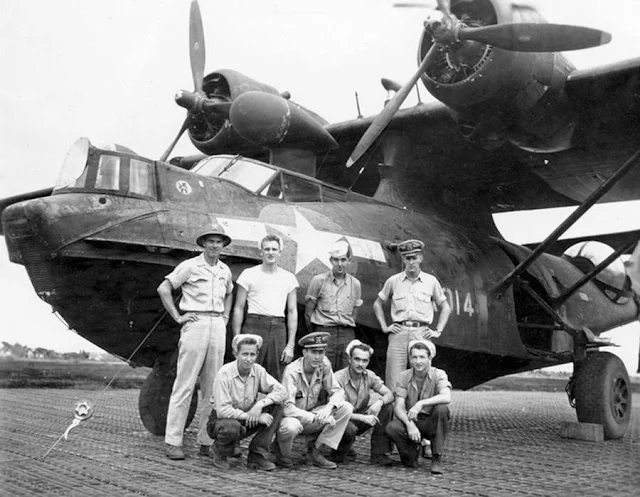 |
| PBY Catalina, VP-71 "Black Cats". |
 |
| PBY-5 Catalina crew of VP-71 “Black Cats”. |
 |
| PBY-5 Catalina crew of VP-44, Midway veterans. |
 |
| PBY-5A Catalina BuNo 48386 of VP-62. |
 |
| Unidentified US Navy PBY Catalina crew in Britain. |
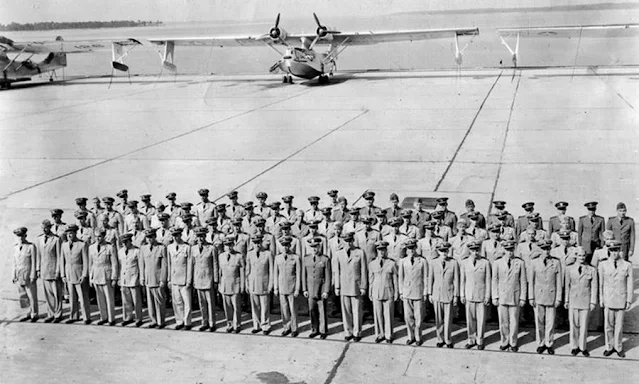 |
| A bunch of newly hatched PBY drivers, NAS Corpus Christi, 1944. |
 |
| NAS Seattle, 1939. Most of the aircraft are P2Ys, but a lone PBY can be seen on the ramp. |
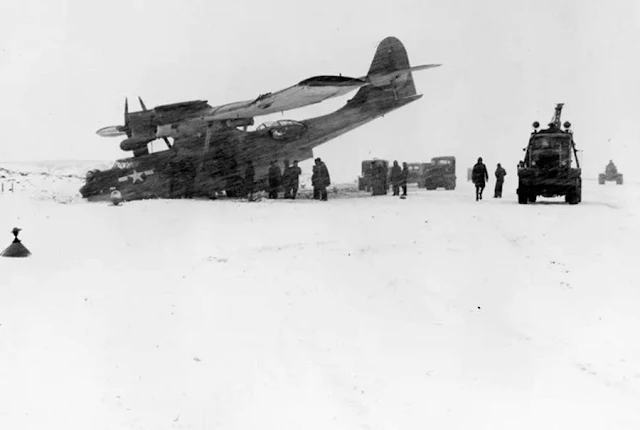 |
| VPB-43 had its share of Arctic mishaps. What appears to be scratches on the photo is actually a blizzard of snow. |
 |
| Men of VPB-43 on duty in the Aleutian Islands. |
 |
| The only PBY sold to a civilian in the pre-war years was this example. Nicknamed “Guba”, it was used for research in the South Pacific. |
 |
| Less repairable is this VPB-43 PBY that experienced engine trouble, landed in the sea, and while being towed back to the harbor had the towline break. Adak Island, May 1945. |
 |
| Same aircraft. As can be seen, this PBY’s flying days were done. |
 |
| Men examine the wreckage to gather up classified material and personal belongings. Nature would soon take care of the rest. |
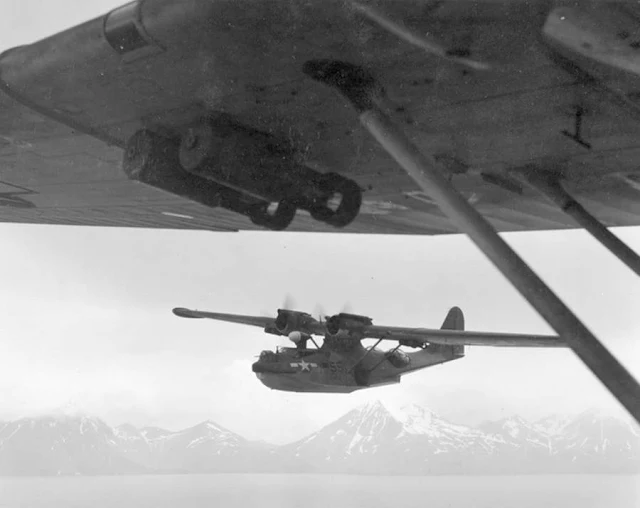 |
| Taken from the radio compartment of an accompanying PBY, the pair patrol the vast Aleutian skies from their base on Adak Island. Depth charges hang from the wings. |
 |
| Pistol cleaning time in a PBY. My first thought was that the man on the left was the aircraft’s navigator using a drift sight. (One can be mounted at the waist blisters.) But nope, he has a gun. |
 |
| Jack Hansen, naval photographer, enjoys the scenery from a PBY. Jack was flying that day to photograph the rescue of a downed P-38 pilot. No pictures of that, because someone else rescued him first. |
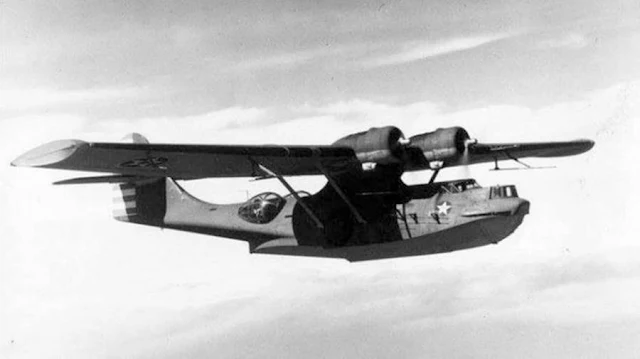 |
| ASE-equipped Consolidated PBY-5A 8 March 1942. |
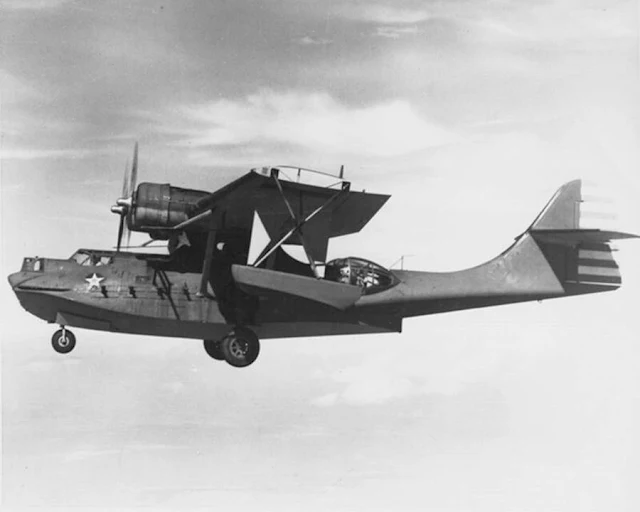 |
| ASE-equipped Consolidated PBY-5A 8 March 1942. USN 403258. |
 |
| ASE-equipped Consolidated PBY-5A 8 March 1942. |
 |
| PBY-5A Catalina. |
 |
| PBY Catalina. |
 |
| PBY Catalina. |
 |
| PBY Catalina. |
 |
| Consolidated XP3Y-1. |
 |
| "Black Cat" PBY Catalina. |
 |
| African-American mechanic Alvin V. Morrison, AMM 3/c, works on PBY at NAS Seattle, Washington, doing overhaul. April 27, 1944. National Archives at College Park 80-G-233274. |
 |
| PBY Catalina in the icy waters of Kodiak Bay, Alaska, 1943. |
 |
| PBYs drone overhead as General MacArthur’s invasion convoy moves into Lingayen Gulf to drop troops and supplies. |
 |
| A PBY passes by Segula Island in the Aleutians. While it makes for a visually interesting picture, the ruggedness of the terrain is also apparent. |
 |
| The PBY with its successor in the Aleutians, the PV-1 Neptune. Both aircraft carry the mid-1943 style national insignia. |
 |
| A PBY-5A amphibian with its wheels lowered for a shore landing in the late-war camouflage and insignia. |
 |
| Consolidated OA-10 Catalina "Snafu Snatcher" assigned to the 2nd Emergency Rescue Squadron in the Pacific Theater. |
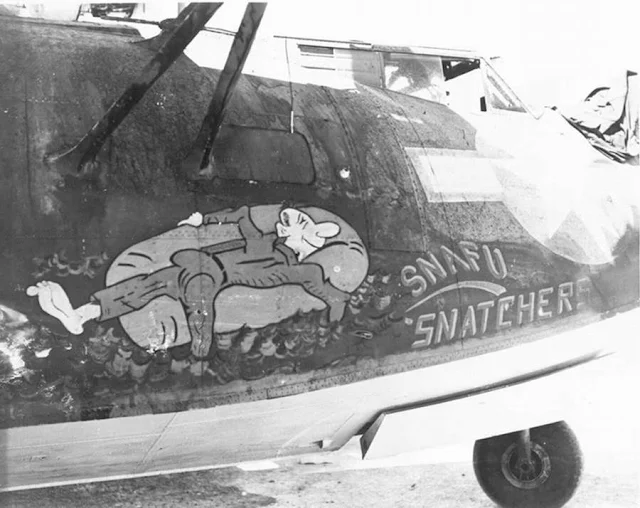 |
| Consolidated OA-10 Catalina "Snafu Snatcher" assigned to the 2nd Emergency Rescue Squadron in the Pacific Theater. |
 |
| Consolidated OA-10 Catalina "Snafu Snatcher" assigned to the 2nd Emergency Rescue Squadron in the Pacific Theater. |
 |
| Consolidated OA-10 Catalina "Snafu Snatcher" assigned to the 2nd Emergency Rescue Squadron in the Pacific Theater. C-47 in the background. |
 |
| Consolidated OA-10 Catalina assigned to the 2nd Emergency Rescue Squadron in the Pacific Theater. |
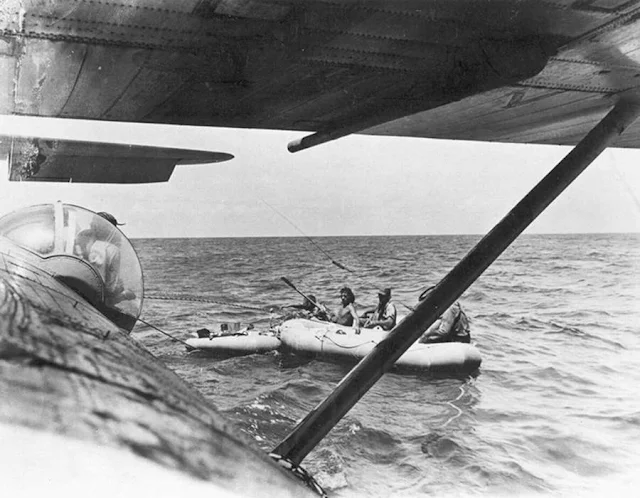 |
| Consolidated OA-10 Catalina assigned to the 2nd Emergency Rescue Squadron in the Pacific Theater. |
 |
| Consolidated OA-10 Catalina assigned to the 2nd Emergency Rescue Squadron in the Pacific Theater. |
 |
| Consolidated OA-10 Catalina s/n 4433876. |
 |
| Consolidated OA-10 Catalina. |
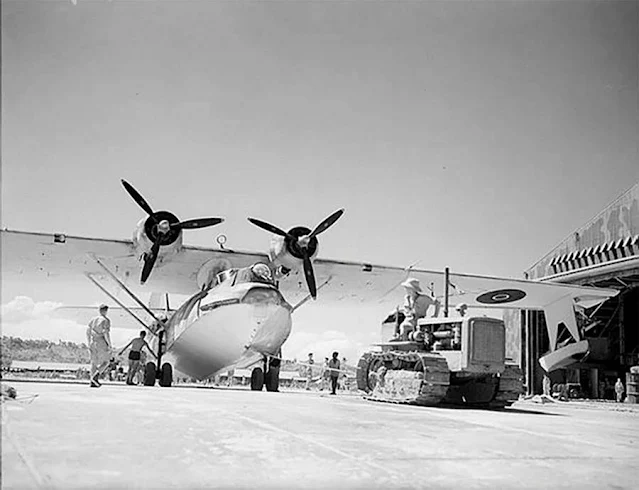 |
| Catalina, RNZAF (Royal New Zealand Air Force) being towed by a crawler tractor, RNZAF Station Lauthala Bay, Fiji, 1944. |
 |
| Another view of the port waist gun position, the can on the left of the gun held ammunition, that on the right collected the spent cartridges. |
 |
| Here the gunner prepares to board the aircraft with his weapon using the detachable ladder. Note that the fuselage is camouflaged in two different colors. |
 |
| No tip warning markings on this propeller. This picture also shows details of the wing bomb attachment paints and landing light. |
 |
| Given the fill point being serviced this is the oil tank being topped off. Radial engines were notorious oil leakers. Another aircraft with the varnished propeller blades. |
 |
| A close up view of a PBY on the ramp with the crew visible at their stations. Crew size could vary between six to eight depending on the mission and equipment carried. |
 |
| A rather worn PBY-5A over the ocean. The white dots over the rear fuselage are insulators for an extensive array of antenna wires, also note the ASV radar antenna under the starboard wing. |
 |
| Passing documents to the co-pilot of a VP-51 PBY. |
 |
| Line handlers stabilize the PBY while it is being readied to come up the ramp. National Air and Space Museum Archives, Hans Groenhoff Photo Collection. |
 |
| A Case tractor is secured for towing on the seaplane ramp. National Air and Space Museum Archives, Rudy Arnold Photo Collection. |
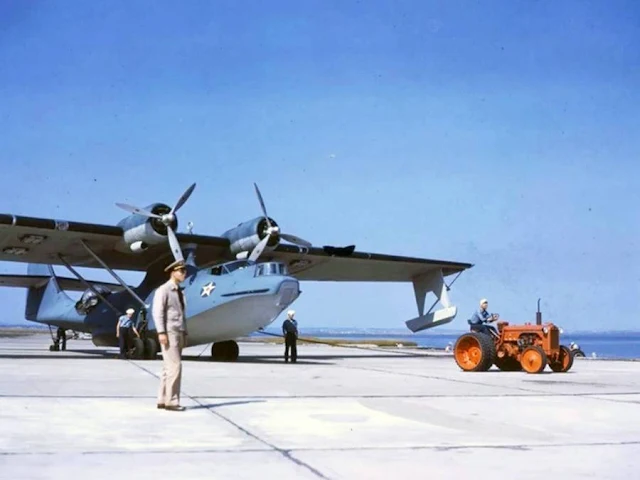 |
| The PBY is ready to move. National Air and Space Museum Archives, Rudy Arnold Photo Collection. |
 |
| A PBY-5A framed by the twin tails of the aircraft which supplanted, but never entirely replaced the Catalina in service, the Martin PBM Mariner. |
 |
| Sailors perform engine maintenance at NAS New Orleans. The Catalina is in the graded camouflage scheme and carries the national markings authorized in August 1943. |
 |
| A Catalina on the ramp displaying her waist gun and rather intricate radio antenna rig. |
 |
| Pilot at the Naval Air Base, Corpus Christi, Texas. Photo dated August 1942, by Howard R. Hollem. Farm Security Administration, Office of War Information Collection, Library of Congress. |
 |
| Consolidated PBY pilots’ controls. |
 |
| Consolidated PBY-5 pilots’ controls. |
 |
| Consolidated PBY-5A Catalina pilots’ controls. |
 |
| Flight engineer's compartment of PBY-5. |
 |
| Consolidated XP3Y-1 prototype model designation. Initial flight, Naval Air Station Norfolk, Virginia, March 21, 1935. |
 |
| Consolidated PBY-2. |
 |
| Consolidated PBY-3. Fitted with R-1830-66 1,000hp engines, 66 produced. |
 |
| Consolidated PBY-4 BuNo 1241 VP-13 13-P-12 testing blisters and new tail surfaces. |
 |
| Consolidated XPBY-5A. One PBY-4 converted into an amphibian and first flown in November 1939. |
 |
| Naval Aircraft Factory PBN-1 Nomad March 1944. Taller fin and rudder systems; aerodynamic and hydrodynamic improvements to airframe. National Archives 80-G-217026. |
 |
| Consolidated PBY-6A. Search radar installed. |
 |
| Consolidated XP3Y-1, 23 April 1935. |
 |
| A U.S. Navy Consolidated PBY-1 of patrol squadron VP-12 in 1937. VP-12 was based at Naval Air Station Seattle, Washington, at that time. US Navy photo. |
 |
| VP-12 PBY-1s overfly USS Langley in Alaska in 1938. |
 |
| Consolidated XP3Y-1 BuNo 9459 11-P-1 of VP-11F, San Diego, California, March 26, 1937. |
 |
| Consolidated PBY-1 BuNo 0120 11-P-8 of VP-11F, San Diego, California. |
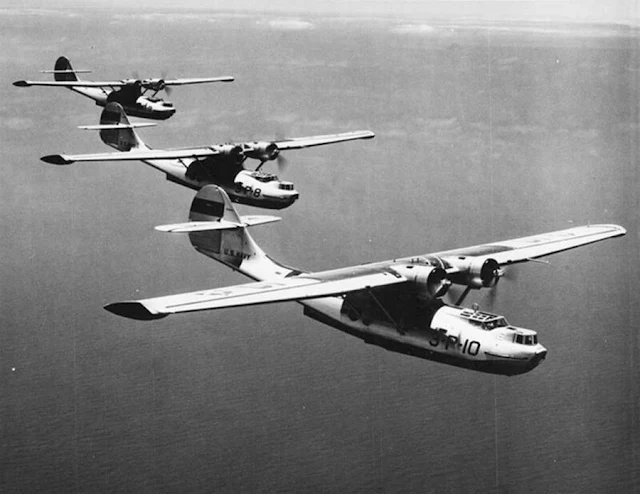 |
| Consolidated PBY-1 BuNo 0122 3-P-10 of VP-3, NAF Coco Solo, June 15, 1937. |
 |
| Consolidated XP3Y-1 .30-cal. waist gun position, May 15, 1936. |
 |
| Consolidated PBY-1 .30-cal tunnel gun position, September 30, 1936. |
 |
| Consolidated PBY-2 BuNo 0454 11-P-12 of VP-11. |
 |
| Consolidated PBY-2 42-P-7 of VP-42, Alaska. |
 |
| Consolidated PBY-2 BuNo 0454 54-P-10 of VP-54, first USN plane with radar, NAS Norfolk. |
 |
| Consolidated Model 28-1 NC777. |
 |
| Consolidated Model 28-1 NC777 San Diego 1937. |
 |
| Consolidated Model 28-1 NC777 San Diego. |
 |
| Consolidated Model 28-1 NC777 "Guba" San Diego. |
 |
| Consolidated PBY-3 BuNo 0842 October 1937. |
 |
| Consolidated PBY-3 BuNo 0842 October 1937. |
 |
| Consolidated PBY-3 torpedo launch 10 October 1941. National Archives 80-G-11375. |
 |
| Consolidated PBY-3 Sea Horse transport conversion NAF Coco Solo July 1943. |
 |
| Consolidated PBY-4 VP-13 NAF Pearl Harbor 30 September 1939. National Archives 80-G-410728. |
 |
| Consolidated PBY-4 VP-7 NAS San Diego. |
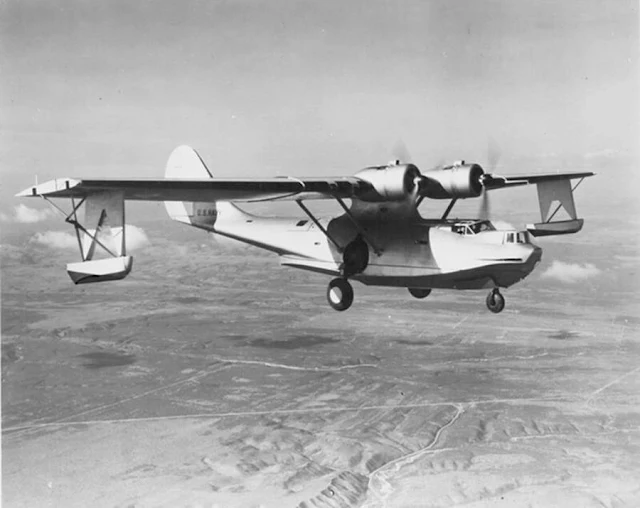 |
| Consolidated XPBY-5A BuNo 1245 San Diego 1939. |
 |
| Consolidated XPBY-5A BuNo 1245 San Diego 1939. |
 |
| Consolidated XPBY-5A BuNo 1245 Sea Mare converted to flying boat as a transport 1939. National Archives 80-G-300779. |
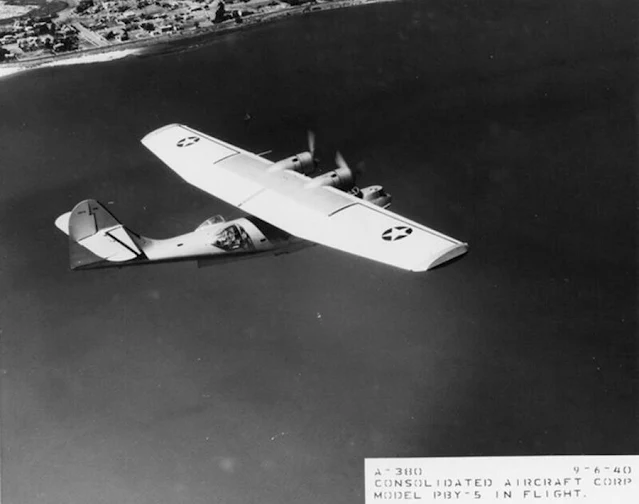 |
| Consolidated PBY-5, 6 September 1940. |
 |
| Consolidated PBY-5 s/n V-189 USCG October 1940. |






